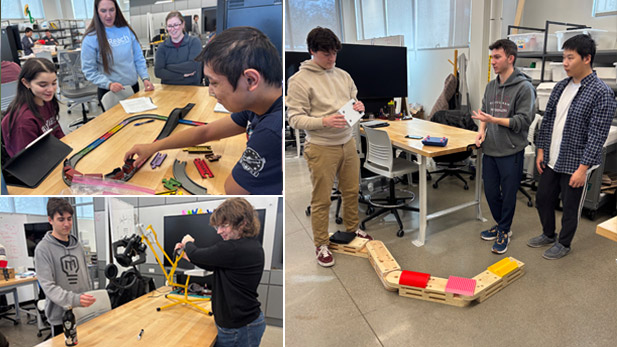First-Year Engineering Design Students Put Creative Toys to the Test

Engineering Design students complete half of their six studio experiences within the first year of the unique and newly accredited program, learning to apply elements of product design, testing, and risk analysis to their creative projects.
First-year Engineering Design program students may not be coming up with ways to build a better mouse trap, but they’ve using the unique program’s creative studio experiences to apply elements of product design, testing, and risk analysis to improve specialized educational toys that will make a difference in children’s lives.
Six toys were designed and created this fall by student teams through computer assisted design, 3-D printing, laser metal cutting, and woodshop technology. Then, different teams spent this winter examining if project elements needed to be redesigned to meet industry safety and quality control standards. Changes also resulted from feedback offered by therapists, staff, and young individuals with special needs associated with Terre Haute’s Reach Services Inc., a longstanding client of the program.
At the same time, Engineering Design program director Patsy Brackin, PhD, and Richard House, PhD, associate dean of professional development and professor of English, were passing along valuable lessons about the social impact of the students’ current and future projects. Classroom sessions are taught in one of the design rooms on the first floor of the Fowler Academic Building.
Stress testing deteriorated several edges with the original hard plastic building blocks that were the basis for a Sentence Stacker speech therapy toy. Students Will Heil, Abbey Hileman, and Brooklyn Keifer came up with a solution: creating blocks from lightweight 3-D printed plastic material so that would be easy to handle, resistant to long-term wear, and washable to help alleviate health concerns.
When put together a child could align the five words on the multi-colored blocks to form the sentence “The Cat Loves to Sleep.”
Pointed edges on parts of a Story Train toy were areas of concern addressed by the team of Jason Chung, Scott Papasine, and Mary Sclafani. The project featured different shaped train track section pieces for each of six basic elements of sentence structure (including nouns, verbs, and adjectives) that when linked together could form phrases – and successfully keep the train moving to the end of its route. Drop testing and client feedback also created project improvements, like adding overpass bridges and longer train track sections to further enhance the educational experience.
“This toy is a fun way to put together words to create sentences and how the different parts of language work together,” said Sclafani. “We were learning by doing a hands-on project, which is why I wanted to go into the Engineering Design program.”
A Wobbletron balance beam required lengthy testing to examine the project’s sturdiness as children walked across the four linked wooden platform pieces. Six texture toppers placed along each beam section allows walkers to feel different sensations along the journey. Completing the next stage in the project development process were Logan Fiorito, Than Mather, and Yuanhe Wang.
“We had to look at the project from a child’s perspective, making sure their little fingers or toes wouldn’t get pinched at any of the critical joint parts,” said Fiorito.
Meanwhile, Isaiah Rohrs and David Wonderlich put The Crane through a series of tip and drop tests to insure the safety of energetic children. They also redesigned the crane’s closing mechanism to pick up smaller items, like a fine-tipped marker, ball, or cube – helping children improve their gross and fine motor skills.
Other projects included the Speech Board, a device improved upon by Carrie Clore, Ethan Moen, and Grace Trask. It features nine interchangeable buttons that could help therapists assist children in identifying an assortment of 34 words and numbers. A Scrambled Sequences game now allows for better movement of elements on the playing surface, helping children with logic and problem solving skills. Being able to change or customize words/objects within any game piece was another enhancement. This important second stage was created by Brahm Cole, Benjamin Gleason, and Hayden Rogstat.
The design sequence will continue this spring with the first-year students completing another fun-filled project of their own creation while learning about sensors, computer coding, and therapeutic aspects of game design.
“I like art and hands-on things, and the Engineering Design projects have allowed me to be creative in so many ways,” said Trask. “The program is good for people who like to make things. It’s been a lot of fun so far and can’t wait to see what’s ahead.”
Learn more about aspects of the Engineering Design program at rose-hulman.edu/engineeringdesign.